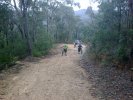You are hereForums / By Discipline / Mountain (off road) / MTB Gear / Tubeless
Tubeless
Can anybody give me a crash course in running tubeless tyres.
I've just bought a bike on Ebay and it has Mavic X819 wheels with Hutchinson Python NG tubeless.
What pressure do I run them at?
Do I need to use Stan's no tubes or the like?
What happens if they deflate - can I just pump them up again?
Is there any special maintenance required?
I'm about 85 kilo's, ride trails and wouldn't jump off anything over 1 metre.
- Login to post comments
Tags

In answer to your questions:
- Run them at 34 front and 37 rear or thereabouts for your sort of riding, others will say higher but they be fules ;-}
- You don't need stans but many (including me) choose to use it anyway as it solves many small punctures without hassle and puncturing a tubeless tyre is a bit more of a hassle than tubed.
- If they deflate you'll need at least a track pump and probably a compressor, ie the LBS. the reason being you need to generate high pressure fast to get the seal between tyre and rim. Or you could try the stans soapy water method, have a look at their website I guess.
- No special maintenance, that's the point! You just need to watch your tyre pressures and It's a little harder to change tyres when the old ones run out of rubber.
Ta,
Matt.
Hiya Paul
Congrats on the new toy.
If the tubeless tyres have been setup properly, (with the guey stuff in the tyres) no need for any extras.
I always carry a tube just in case but buy yourself a CO2 attachment http://www.topeak.com/2007/products/minipumps/on... and a couple of cartridges http://www.phantomcycles.com.au/product.php?prod... . If the tyre goes down to far (almost off the rim) and its only a small puncture use the CO2 to inflate it. You can also use a normal pump if it only goes down a little bit. If the hole is too big or you have time use the tube.
As for pressures thats the great debate. I'm about 86kg and run my tyres at about 40psi but that also depends on whatr surface I ride on. Typically higher pressures for tarmac and firetrails. Lower pressures technically and loose stuff. But thats my opinion.
Other than that keep any eye on your pressures before you ride and you should be sweet.
Cheers
Evan
http://nobmob.com/node/1579 - Tubeless Debate
http://nobmob.com/node/1422 - Tyre Pressure
Evan
Thanks guys, I didn't realise there had been so much discussion on this subject. Next time I might use the sites search function before asking.
Now if I have this straight;
The lower the pressure, the greater the grip, the greater the resistence, the plusher the ride, the greater the risk of rolling a tyre, which can only be fixed in the bush with a tube.
The higher the pressure the better the roll, the lesser the grip, the harsher the ride, the greater the chance of burping.
Things to remember;
Check tyre pressure before riding (tick)
Carry a spare tube (tick)
CO2 pump (tick)
Invest in Stan's No Tubes when next changing tyres (to do)
Pressure - mid 30's front and high 30's back (currently 40 back and front)
Get LBS to show the secrets of changing tubeless next time I change tyres.
Is there anything else I missed?
Paul
You have pretty much summed it up correctly.
You should only need the tube if you don't have the gu stuff in the tyres, have a major tyre issue or cannot pump your tubeless tyres up with a hand pump.
Cheers
Evan
The tires can be hard to get on and off but the centre of the rim has a smaller diameter than the area the bead seals, to get a tire off push the beads towards the centre then use the tire levers, same method to fit a tire but before I grab my track pump I grasp the side walls of the tire and pull the bead to the outer part of the rim, I do this right around the tire and then have no trouble inflating the tire with a track pump.
John
While the "higher the pressure the better the roll" is true on the road, off road its a bit more complicated. Have a read of this http://schwalbetires.com/wider_faster_page
Alchemist - I had it all neatly packaged and ready to file and then you started messing with my brain.
I can see the logic of what they are saying - fatter low pressure tyres don't sink into soft ground and they absord small impacts, while hard narrow tyres sink more and transfer the impacts to the frame/shocks.
OK that might be fine for the trails of Europe, but riding in the mud of Red Hill and Oxford Falls, experience tells me that the greater the tyre footprint, the greater the suction and the harder the going is. In sand it is probably the opposite - clear as mud.
Note to self "trail condition" is another variable to consider.
Thanks for the input.